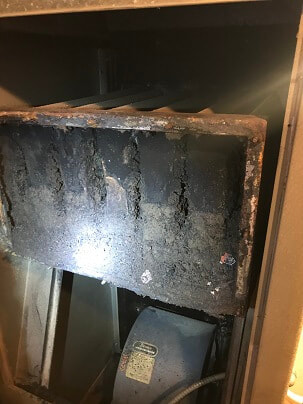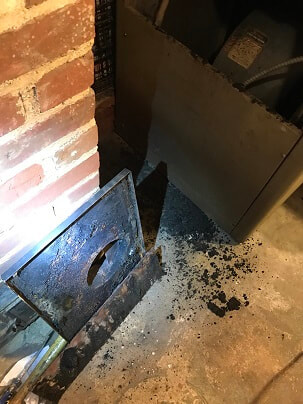|
The heat exchanger pictured is definitely not representative of our typical job. Furnace cleaning, when performed regularly, is relatively uneventful, as the technicians use high-pressured air triggers to clean various components inside the furnace, and check key areas for proper function. The goal is to rid the furnace and its inner workings of dust and debris that hinder efficiency and that increase the number of contaminants polluting indoor air. As in any frequent task, however, sometimes unusual or exemplary situations present themselves The symptoms This month a homeowner in St Paul contacted us and scheduled a furnace flue cleaning as well as a furnace cleaning. His gas furnace, manufactured in the 1950s, was less efficient than it had been (not surprisingly, some would say). More importantly, he felt it was not drafting properly. He was getting what he called "funny smells" in the house, and the carbon monoxide detectors were going off. The customer attributed this to a clogged furnace flue, which is certainly not an unlikely cause. The furnace flue serves to vent harmful gases produced during combustion to the outside, so if it is clogged or otherwise hindered, it stands to reason that a primary indicator would be the CO detector registering concerning levels of carbon monoxide. The diagnosis After listening to the homeowner's concerns about the furnace not drafting properly, the technician proceeded to clean the flue, expecting to find it clogged, perhaps with animal nesting or other debris. Though quite dirty, however, it was not so dirty that one would have expected air flow to be greatly hindered or draft compromised. The problem became apparent, however, when the technician was able to see, by way of the access created for the flue cleaning, down into the heat exchanger. It was completely clogged and black with soot, to an extent he'd never seen before. It was clear to the technician that a through cleaning was urgently needed to unclog it and restore it to working order, if possible. A disclaimer would be in order at this point. The average lifespan of a furnace is about 20 years, and the furnace in question was significantly older than that. The customer insisted, however, that it was otherwise working properly and he simply did not have the funds to replace it. Wanting to accommodate the customer's financial situation, the technician agreed to proceed with the disassembly and cleaning of the heat exchanger, with a thorough explanation of what he was doing and the risk involved, and an assurance from the customer that if the symptoms persisted after the cleaning he would consult a repair company. An interesting aside: furnaces of this age rely on natural draft to exhaust gases and are not equipped with a draft inducer. This component is essentially a fan, found in modern furnaces, whose purpose is to create draft and move the products of combustion from the furnace up and out the flue. A furnace equipped with a draft inducer likely would shut down rather than becoming as clogged as this one had, in accordance with its sequence of operation. The solution
The technician began the job by removing 17 nuts and bolts from the panel just to gain access to the heat exchanger. As soon as the panel was removed, it was clear that the gasket surrounding it was completely deteriorated and needed to be replaced. The customer purchased a new one while the technician performed the cleaning. It is unusual that a technician would need to go to such lengths to access a heat exchanger. Typically the heat exchanger is readily accessible, or requires only minimal disassembly in order to access it for cleaning. Moreover, many technicians would likely have passed on this job once observing the amount of buildup needing to be cleaned and the relatively laborious process of accessing the heat exchanger. Likely the customer would have been counseled to simply replace the furnace. However, a combination of a genuine wish to help a homeowner in a tough financial situation and the desire to successfully tackle a challenging and uncommon task inspired our technician to complete the cleaning. Once the heat exchanger was accessible, the cleaning was carried out using a powerful industrial vacuum and various attachments, specifically a 3-inch round brush head. Because the heat exchanger and its associated tubes were so large, it was easy to fit the vacuum and its attachments down each tube, which made this aspect of the cleaning relatively easy, taking only about 20 minutes. On completion, the customer replaced the gasket with the one he had purchased, and the heat exchanger panel was reinstalled. The lesson The heat exchanger after the cleaning was not necessarily a thing of beauty, but it certainly was in a much improved condition to carry out its function of heat transfer. In the end, the tech was wiser, the customer was well-informed and happy, and he also was not out thousands of dollars for the purchase of a new furnace—at least not today. Wanna dig deeper? Download our free tipsheet: 5 Questions to Ask Before Hiring a Furnace Cleaning Company. Download Tipsheet Many thanks to our technicians Ben S and Roy S for lending their expertise to this article.
0 Comments
|
SearchArchives
April 2022
|
Twin Cities Furnace Cleaning - Open 7 Days a Week 8AM to 8PM


